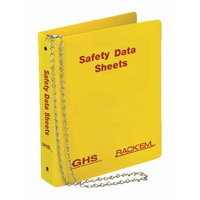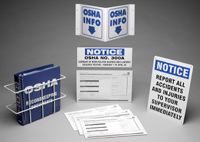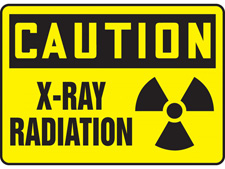 |
 |
| MSDS Topics |
Free Sites | FAQ's | Regulations | Glossary | Software | Suppliers |
| Books | Forum | Poll | Fun stuff | Quiz | Store | |
| MSDS and safety supplies | Search ALL our MSDS info | |||||
 | |||
 |
 |
 |
|
| Title: 02/06/1997 - The dental industry's concerns regarding compliance with certain provisions of the Hazard Communication Standard (HCS). | |
| Record Type: Interpretation | Standard Number: 1910.1200 |
February 6, 1997
Linda M. Chatwin, Esq.
General Counsel
Ultradent Products Incorporated
505 West 10200 South
South Jordan, Utah 84095
Dear Ms. Chatwin:
|
The Occupational Safety and Health Administration (OSHA) has, over the past year and a half, undergone extensive discussions with the American Dental Trade Association (ADTA) in an attempt to resolve the dental industry's concerns regarding compliance with certain provisions of the Hazard Communication Standard (HCS). One such concern was the necessity of MSDSs for dental devices, as these devices are already regulated under Food and Drug Administration (FDA) labeling provisions. As fully explained in the enclosed letter to Mr. Thomas Fise of the American Dental Trade Association (ADTA), OSHA has determined that MSDSs are required for dental devices which are not exempt from coverage under the "article" or "consumer products" provisions of the HCS. As you correctly note, the agency's stay of enforcement was lifted on December 16, 1996, and the dental industry is therefore expected to comply with the provision of the HCS. OSHA does not envision a change in its position on this issue, which resulted from a thorough and exhaustive analysis of the issues raised by the ADTA. If we may be of further assistance, please do not hesitate to contact us.
|  Get your MSDS binders, posters, signs and more at Safety Emporium. |
Sincerely,
Stephen Mallinger, Acting, Director
Office of Health Compliance Assistance
December 11, 1996
Ms. Ruth McCaulley
OSHA Office of Health Compliance Assistance
200 Constitution Avenue N.W.
Washington D.C. 20210
Dear Ms. McCaulley:
I would appreciate receiving an update of OSHA's position regarding MSDS requirements for dental devices. I understand that the 120 day stay of enforcement as to FDA regulated dental devices has now passed. Please let me know whether OSHA is now in a position to make this stay permanent or whether other solutions for the MSDS problem in the dental field are at hand.
I appreciate your help and response in this matter.
Thank you.
Sincerely,
Linda M. Chatwin, Esq.
General Counsel
January 7, 1997
Thomas F. Fise, Esq.
Special Council, Regulatory Affairs for the American Dental Trade Association
4900 B South 31ST Street
Arlington, Virginia 22206
Dear Mr. Fise:
Thank you for your letter of November 21, addressed to Ms. Ruth McCully of my staff and sent as a follow up to the October 11 meeting between yourself, representatives of the Occupational Safety and Health Administration (OSHA), Office of Solicitor (SOL), and the Food and Drug Administration (FDA). This letter provides a recapitulation of the Hazard Communication Standard (HCS) issues that have been under discussion with the ADTA, the Agency's conclusions, and brief explanations for those conclusions.
FDA and OSHA Jurisdiction
 Comply with OSHA 300 requirements with centers and forms from Safety Emporium. | One of the ADTA's issues concerned the perceived overlap between FDA and OSHA in the regulation of dental devices. Throughout this process, we have worked closely with FDA to ensure that the integrity of jurisdictional boundaries was respected and maintained, and we hope that, with the assistance of the FDA representatives, we were able to provide you with a better understanding of our respective jurisdictional boundaries regarding dental devices. OSHA's jurisdiction is limited to employees' exposure due to handling or use of hazardous chemicals in the workplace. FDA is concerned with product efficacy and patient safety. Given these different statutory and regulatory mandates, OSHA and FDA were unable to identify any clear areas of regulatory overlap. One issue of specific concern to the ADTA was labeling. We informed you that dental devices which require labeling under FDA regulations are exempt from OSHA's HCS labeling requirements (29 CFR 1910.1200(b)(5)). |
In your December 12 correspondence, we note your position that Material Safety Data Sheets (MSDSs) fall within FDA's definition of labeling. As we have discussed in earlier meetings, this is unfounded. As the FDA has neither prescribed nor enforced regulations requiring manufacturers to transmit information on the hazards of chemicals to downstream users by means of MSDS's, FDA's labeling provision for Dental Devices is not duplicative and would not meet the criteria of a (4)(b)(1) pre-emption of the OSH Act. 29 USC Section 653(b)(1). This is further discussed in the preamble to the HCS final rule. 59 Federal Register 6126, 6149-50 (Feb. 9, 1994) (package inserts accompanying FDA regulated dental devices cannot be considered to be material safety data sheets (MSDS)).
Dental Devices Covered by HCS
Another issue concerned the identification of dental devices that are covered by the HCS. In our communication of August 22, 1995, from Assistant Secretary Joseph A. Dear, we made a commitment to "provide further compliance assistance to the ADTA to ensure that the industry is fully applying all the existing HCS exemptions." OSHA worked closely with FDA in this effort. We conducted a broad hazard determination of the FDA's defined classes of dental devices, beginning with a review of FDA regulation, 21 CFR 872, Dental Devices. Next, we excluded devices that failed to meet the HCS definition of a hazardous chemical. We also excluded those devices that met the "article" and "consumer product" exemptions under the HCS (29 CFR 1910.1200(b)(6)).
|
In this regard, articles are exempt under the HCS if they are "a manufactured item other than a fluid or particle: (i) which is formed to a specific shape or design during manufacture; (ii) which has end use function(s) dependent in whole or in part upon its shape or design during end use; and (iii) which under normal conditions of use does not release more than very small quantities, e.g., minute or trace amounts of a hazardous chemical (as determined under paragraph (d) of this section), and does not pose a physical hazard or health risk to employees." If a dental device does not potentially release hazardous chemicals during normal use, it would be considered an article, e.g., an endosseous implant, a dental chair, a dental handpiece, an x-ray unit, all would be considered articles and would be exempt from the HCS. If hazardous chemicals are released during normal use, the manufacturer is required to create an MSDS.
|  Get X-ray and radiation safety signs and tapes at Safety Emporium. |
Likewise, consumer products are exempt, "where the employer can show that it is used in the workplace for the purpose intended by the chemical manufacturer or importer of the product, and the use results in a duration and frequency of exposure which is not greater than the range of exposures that could reasonably be experienced by consumers when used for the purpose intended." The standard requires the employer to ascertain whether the workplace use is more frequent or of longer duration than would be expected in normal consumer use. Exposures in workplace situations can be greater than a consumer would experience, and thus, the need increases for additional information for employee protection.
In order for the exemption to be applied, the consumer product must have the same chemical composition, intended use, and potential for exposure as a specific dental device. In this regard, let me stress that to qualify for the consumer product exemption, the Standard provides two criteria which must be met. These are that the dental device, 1) must be used by the consumer and dental professional in the manner intended by the manufacturer, and 2) is a consumer product as that term is defined in the Consumer Product Safety Act, 15 U.S.C. 2051 et seq. In your November 21 correspondence, we note that although consumer products were identified which contain chemicals also found in dental devices, the items fail to meet criteria for a consumer product under the HCS. For example, stove-gasket cement and joint crack sealant have a different intended use by a consumer than the use of porcelain powder by a dentist or a dental technician.
Our hazard determination effort generated two tables of dental devices referenced by class (enclosed). The first table identifies "Dental Devices Which Require Manufacturer's Determination for Presence of Hazardous Chemicals and, if Present, Would Then Require a MSDS." The second table identifies "Dental Devices Not Covered by the Hazard Communication Standard." Please bear in mind that these lists represent a preliminary hazard determination performed on a broad category of dental devices. The device manufacturer or importer maintains the responsibility and right to perform a more specific hazard determination to decide whether or not a particular device may be considered a hazardous chemical(s) under the HCS. The HCS requires that a MSDS be generated only if the device contains a hazardous chemical as shown by the manufacturer's or importer's hazard determination.
Small Quantity Use
| (sponsored information) 400,000 MSDS's in your shirt pocket... |
ADTA was also concerned regarding the HCS coverage for dental devices that are often used in relatively small quantities. As proposed by Assistant Secretary Joseph A. Dear in his letter of November 22, 1995, this issue was referred to the National Advisory Committee on Occupational Safety and Health (NACOSH) Hazard Communication Workgroup. This Workgroup was established in response to The President's Report, "The New OSHA," issued in May, 1995, and was composed of professionals with expertise in hazard communication representing small and large businesses, unions, state governments, and consulting firms (see pages 13 and 14 of the enclosed report for a listing of Workgroup members.) The mission of the Workgroup was to provide OSHA with recommendations to simplify MSDSs, reduce the amount of required paperwork, improve the effectiveness of worker training, and revise enforcement policies so that they focus on the most serious hazards. In all our meetings and correspondence we invited and urged ADTA's participation in this process. In your absence, we presented to the NACOSH Hazard Communication Workgroup the "small quantity issues" on ADTA's behalf. The NACOSH Workgroup issued its report on September 12, with their findings and recommendations. The "small quantity issue" is discussed on pages 84 through 86 of the report. The Workgroup's conclusion on this issue follows: "...that a small quantity exemption that could be uniformly applied in all workplaces could not be identified. In addition, workgroup members agreed that all workers deserve equal protection, and they could not quantify any small quantity exception at this time that would balance the above factors appropriately. Therefore, the workgroup does not agree that an across-the-board small quantity exemption should be developed, and further believes that such an exemption could actually increase the compliance burdens associated with the standard." |
Please remember, that the HCS is an information transmittal standard triggered whenever a substance is covered as a hazardous chemical. The fact that a chemical poses a potential hazard is different from the concept of risk. The risk that a chemical presents is dependent upon the concentration, frequency, and duration of exposure. The standard requires the development of MSDSs based on the intrinsic properties (i.e., corrosivity, irritation, sensitization, etc.) of a hazardous chemical, not on predictions about the level of risk experienced by particular employees.
Transmission of MSDSs
Another concern discussed was the transmission of MSDSs for dental devices by manufacturers, importers, or distributors. In our October 11 meeting, we discussed options that would reduce compliance costs. The HCS requires MSDSs to be sent with the initial shipment of a hazardous chemical and when the MSDS is updated. An alternative method of sending MSDSs to downstream users is by electronic transmission. For example, MSDSs may be transmitted by available technology such as telefaxes, electronic bulletin boards, Internet, and CD-ROM/floppy disks to eliminate the need to send paper copies. Both the MSDS sender and receiver must be equipped and agreeable to the electronic transmission. We have been informed that there are a number of manufacturers in a variety of industries that are successfully using electronic transmission of MSDSs.
Conclusions
In summary, based upon our discussions, the information provided by FDA and ADTA and our extensive review of the issues, the Agency has concluded the following:
|  Ensure that your MSDS collection is "readily accessible" with these handy compliance centers from Safety Emporium.
|
Finally, as you know, the Agency issued a temporary enforcement stay on May 16. This allowed OSHA the opportunity to conduct a broad hazard determination for the FDA classes of dental devices. During this interval, NACOSH proceeded with its task of reviewing pertinent HCS issues and published its final report. In addition, the stay permitted OSHA to carefully consider all other issues raised by ADTA. We believe that with the assistance of the FDA, ADTA, and NACOSH, the Agency has conducted a thorough evaluation of these issues within the parameters of the HCS and the OSH Act. As a result, OSHA ended its temporary enforcement stay on dental devices effective December 16.
We appreciate your cooperation throughout our discussions and the industry perspective you presented. We valued your participation in the process and your interest in worker safety and health.
Sincerely,
John Miles, Jr., Director
Directorate of Compliance Programs
Enclosures
Table No. 1. Dental Devices Which Required Manufacturer's Determination for Presence of hazardous Chemicals, and if Present, Would Then Require a MSDS
Table No. 2 Dental Devices Not Covered by the Hazard Communication Standard
The official, public domain, OSHA version of this document is available at http://www.osha.gov/pls/oshaweb/owadisp.show_document?p_table=INTERPRETATIONS&p_id=22343&p_text_version=FALSE